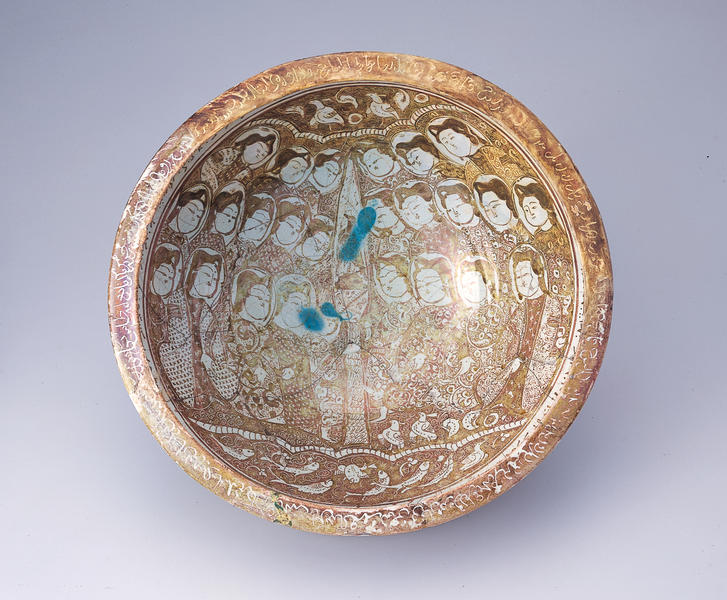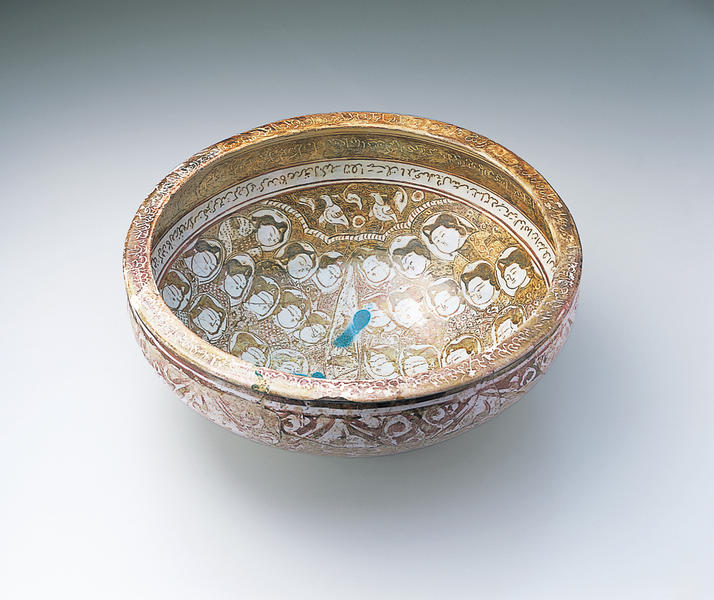ラスター彩群像図鉢
- イラン
- 13世紀初期
- 13c
- 複合陶土、カーシャーン様式
- H-14.9 D-35
器面いっぱいに女性と思われる25人の人物座像が描かれ、全員が中央の鳥の潜んだ樹を見ている。樹の根元には池の中で魚と水鳥が泳ぎ、空にも鳥と浮き雲が描かれている。魚や鳥は天界のものとされることから、聖なる象徴としたとも思われる。
Catalogue Entry
Persian lusterware is sometimes classified stylistically, according to its design, into three groups: the Reyy monumental style, the miniature painting style, and the Kashan style;1 or it is divided into three periods, according to changes in style.2 This bowl is one of the masterpieces of the later period, when Persian lusterware shook off the influences of Egypt and Syria--seen in works from the early periods--developed its own style, and matured.
In this unusual piece, twenty-five seated woman-like figures (the small figure might be a child), placed in three tiers, fill the entire bowl. A cypress reminiscent of the "tree of life" is in the center. Perched on a rock in the foreground, or perhaps hidden among the branches of the tree, is what might be a sacred bird, clearly quite different in size and shape from the other birds. As is often seen in lusterware and mina'i ware from Kashan, there is a pond at the foot of a tree, in which fish and waterfowl are swimming. In ancient Persian literature, fish and birds are often described as creatures belonging to heaven.
All eyes of the figures seem focused on the tree of life and the bird in it. Even the fish and birds in the lower area are oriented toward the tree. A key to interpreting the scene in this bowl might lie hidden here. Similar designs, but with only two figures, are found on in both vessels3 and tiles.4 The latter are similar to those decorating the Imamzade Ja'far mausoleum in Damghan. It is not easy to determine the nature of this gathering, which gives the impression of stillness, as if the twenty-five people were meditating. The gathering may be regarded as a religious congregation, perhaps related to Sufi mysticism or to the Shiite practice of gathering to recite poems to mourn the martyrdom of Husain at Karbala.
TS
1. Watson 1985.
2. Morgan 1994.
3. A lusterware bowl in Okayama Orient Art Museum; two figures sit facing each other, with a cedar between them.
4. An Islamic tile is in the David Collection (Isl. 154).
作品解説(エジプトのイスラーム文様)
ラスター彩群像図鉢
イラン 13世紀初期
径34.9cm
MIHO MUSEUM
肌色の胎土に白化粧をして文様を描いたラスター彩陶器である。器形は低い高台から器壁が斜めに立ち上がり、口縁に向かって丸みをもってすぼまり、口縁部は短く外反している。見込みの文様は、中央に糸杉のような1本の木を中心に、向かって左に13人、右に12人の人物と足元に2羽の鳥を描く。木の中には、台座のようなものに乗った鳥が描かれている。上下を紐で区切って、下部には6匹の魚と2羽の鳥が描かれているが、上部に描かれた2羽の鳥周辺は、修復による復元と思われる。口縁は水平で、釉薬を掻き落としてナスヒー体の文字が書かれている。口縁下の内側には、2段の文字文帯が巡らされている。器の外側には高台を中心に、蕊(しべ)を含んだ大きな花びら形の文様が、勢いの良いタッチで描かれている。
Catalogue Entry
Bowl with an Outdoor Group Scene
Iran, early 13th century
Dia. 34.9cm
Miho Museum, Shiga
White glaze has been applied over a beige body clay, and designs have been created in luster paints. The bowl has a low foot, and diagonally expanding torso walls, with slight rounding near the mouth rim area. The mouth rim area is short and everted. The interior design features a single cedar-like tree in the center with thirteen figures on the left, twelve figures on the right, and two birds at the base of the tree. A bird is seated in the tree on a platform like seat. The areas above and below the scene are delineated by cords, and there are six fish and two birds shown below the lower cord. There is some restoration work visible near the two birds above the scene. The mouth rim area is flat, with an inscription scraped from the glaze in naskhl- style characters. The interior, beneath the mouth rim area, is circled by two bands of script. The bowl exterior is decorated with a large flower petal design that centers on the foot and includes the flower stamen, all painted in well-formed strokes.

